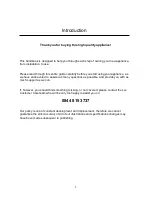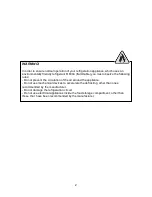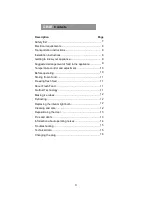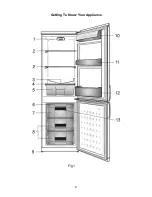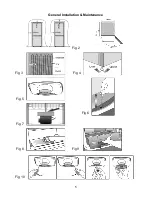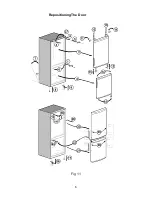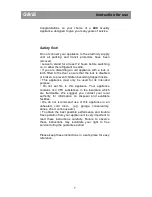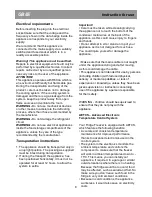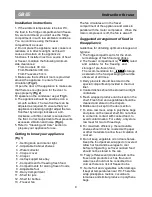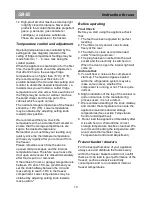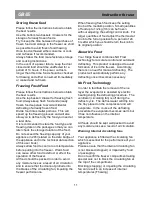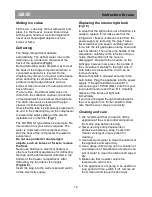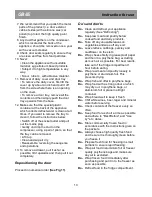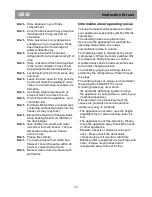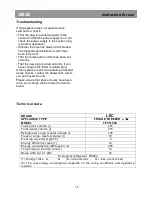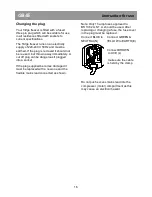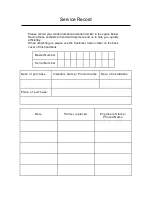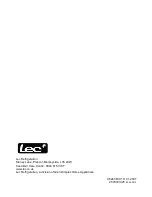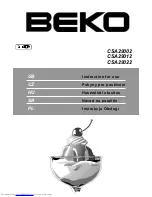
GB/IE
Instruction for use
7. We recommend that you polish the metal
parts of the product (i.e. door exterior,
cabinet sides) with a silicone wax (car
polish) to protect the high quality paint
finish.
8. Any dust that gathers on the condenser,
which is located at the back of the
appliance, should be removed once a year
with a vacuum cleaner.
9. Check door seals regularly to ensure they
are clean and free from food particles.
10. Never:
• Clean the appliance with unsuitable
material; eg petroleum based products.
• Subject it to high temperatures in any
way,
• Scour, rub etc., with abrasive material.
11. Removal of dairy cover and door tray :
• To remove the dairy cover, first lift the
cover up by about an inch and pull it off
from the side where there is an opening
on the cover.
• To remove a door tray, remove all the
contents and then simply push the door
tray upwards from the base.
12. Make sure that the special plastic
container at the back of the appliance
which collects defrost water is clean at all
times. If you want to remove the tray to
clean it, follow the instructions below:
• Switch off at the socket outlet and pull
out the mains plug
• Gently uncrimp the stud on the
compressor, using a pair of pliers, so that
the tray can be removed
• Lift it up.
• Clean and wipe it dry
• Reassemble, reversing the sequence
and operations
13. To remove a drawer, pull it as far as
possible, tilt it upwards and then pull it out
completely.
Repositioning the door
Proceed in numerical order (See Fig 11).
Do’s and don’ts
Do- Clean and defrost your appliance
regularly (See "Defrosting")
Do- Keep raw meat and poultry below
cooked food and dairy products.
Do- Take off any unusable leaves on
vegetables and wipe off any soil.
Do- Leave lettuce, cabbage, parsley and
cauliflower on the stem.
Do- Wrap cheese firstly in greaseproof paper
and then in a polythene bag, excluding
as much air as possible. For best results,
take out of the fridge compartment 1
hour before eating.
Do- Wrap raw meat and poultry loosely in
polythene or aluminium foil. This
prevents drying.
Do- Wrap fish and offal in polythene bags.
Do- Wrap food with a strong odour or which
may dry out, in polythene bags, or
aluminium foil or place in airtight
container.
Do- Wrap bread well to keep it fresh.
Do- Chill white wines, beer, lager and mineral
water before serving.
Do- Check contents of the freezer every so
often.
Do- Keep food for as short a time as possible
and adhere to "Best Before" and "Use
by" etc. dates.
Do- Store commercially frozen food in
accordance with the instructions given on
the packets.
Do- Always choose high quality fresh food
and be sure it is thoroughly clean before
you freeze it.
Do- Prepare fresh food for freezing in small
portions to ensure rapid freezing.
Do- Wrap all food in aluminium foil or freezer
quality polythene bags and make sure
any air is excluded.
Do- Wrap frozen food immediately after
purchasing and put it in to the freezer as
soon as possible.
Do- Defrost food in the fridge compartment
.
13


